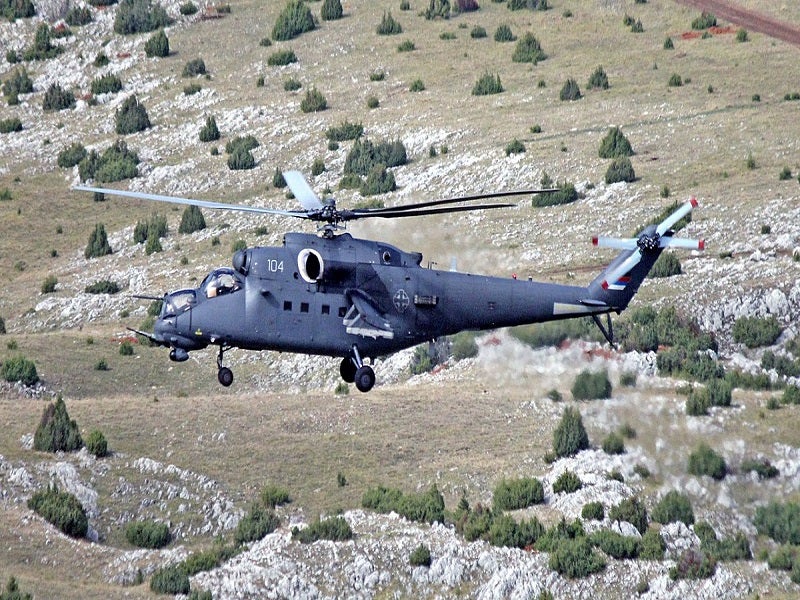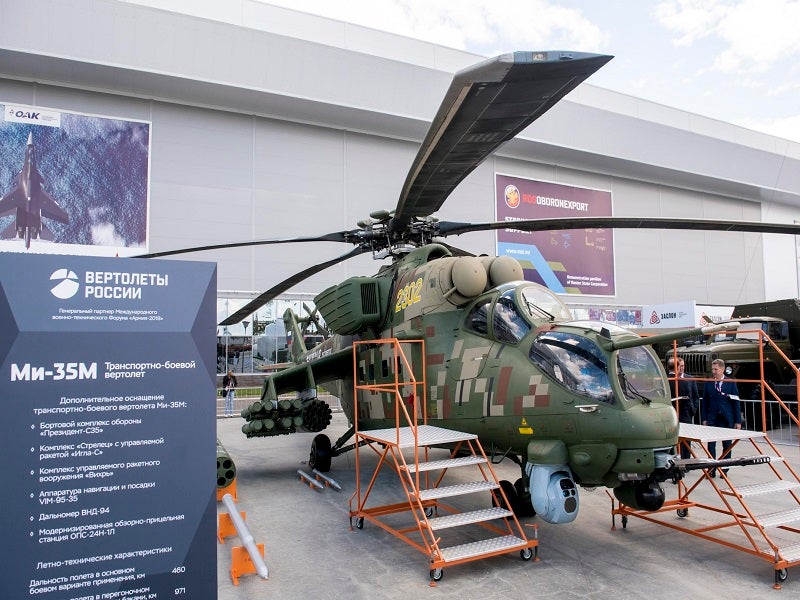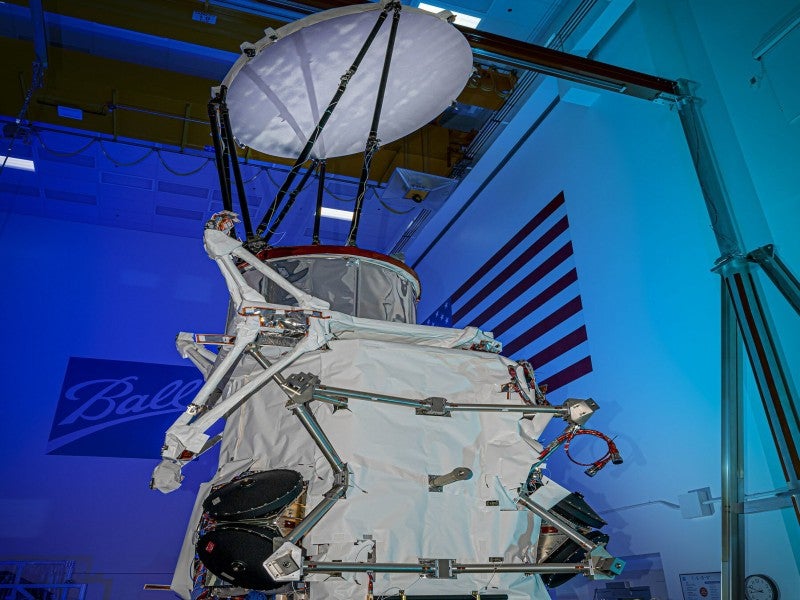Mi-35M is a multi-role combat helicopter manufactured by Rostvertol, a subsidiary of Russian Helicopters. It is an export variant of Mi-24 Hind attack helicopter.
Primarily designed for attack and military transport missions, the helicopter offers a superior flight performance and manoeuvrability compared to its predecessor.
The production of Mi-35M started in 2005. The aircraft integrates modern, high-precision weaponry for destroying ground-based armoured targets and providing air support for ground missions. It can be modified as an attack, ground assault, medical evacuation (MEDEVAC) or transport platform.
Mi-35M is one of the modern combat helicopters in the Russian Air Force inventory. It is also operated by the armed forces of many countries including Venezuela, Azerbaijan, Nigeria, Kazakhstan, and Mali.
The helicopter was displayed at the Army-2021 international military and technical forum in Moscow, Russia, in August 2021.
MI-35M features
Based on the Mi-24 Hind, Mi-35M military helicopter incorporates several improvements, including shortened stub wings, a new rotor system, modern avionics, upgraded turboshaft engines and a hydraulic system. The cockpit and vital components of the helicopter are heavily armoured.
The helicopter has an overall length of 21.6m, wingspan of 6.5m, and height of 6.5m. Its take-off weight in ferry configuration is 12,000kg. It can carry eight troops or a payload of 2,400kg.
Mi-35M military helicopter cockpit and avionics
The glass cockpit of the Mi-35M accommodates two pilots in tandem configuration. The night vision goggle (NVG)-compatible cockpit integrates multi-functional displays (MFDs), redundant flight controls, and state-of-the-art avionics.
The helicopter is equipped with an OPS-24N surveillance-and-sighting station, a television channel, a GPS-guided navigation system, and an optional non-Russian radio station.
Hind E armament
The chin-mounted turret can be installed with the twin-barrel GSh-23V 23mm cannon with 450 to 470 rounds of ammunition. The gun can fire 3,400 to 3,600 rounds a minute. The stub wings can carry a range of weapon systems, including anti-tank missiles, rocket pods/gun pods or fuel tanks.
The military helicopter can be armed with up to eight 9М114 or 9M120 Ataka-V SACLOS radio-guided anti-tank missiles, up to 80 ‘S-8’ 80mm unguided rockets, and 20 ‘S-13’ type 122mm unguided aircraft rockets.
Countermeasures of Mi-35M
The countermeasures suite of Mi-35M includes a radar warning receiver, a laser range finder and a location finder, chaff and flare launch system, infrared (IR) jamming system, and engine-exhaust IR suppressor.
Mi-35M helicopter engines and performance
The military helicopter is powered by two ТVЗ-117VМА or VK-2500 engines. Each engine develops a maximum power output of 2,200hp. The engines are designed to support high-altitude missions.
The helicopter can fly at a maximum speed of 305km/h. Its operational altitude is 5,400m. The helicopter has a normal range of 460km and can reach a maximum distance of 1,000km with full fuel load.
It can be deployed in combat missions in different geographies with high-temperature and high-altitude environments and features round-the-clock combat capabilities for conducting missions during day and night. It is also capable of operating from unprepared and poorly equipped airfields.
Mi-35M orders and deliveries
In 2005, Venezuela signed two contracts with Rosoboronexport for eight Mi-35M helicopters. The helicopters that were delivered to Venezuela were fitted with VK-2500 engines for high-altitude operations.
The Brazilian Air Force (FAB) signed a $150m contract with Rosoboronexport for 12 Mi-35M helicopters in November 2008. The helicopters were manufactured by Rostvertol at its facility in Rostov-on-Don. The first three helicopters were delivered in December 2009.
The Brazilian Air Force started operating three Mi-35M helicopters in April 2010. The helicopters in FAB service are referred to as AH-2 Sabre. Nine helicopters were delivered by August 2012. The final helicopter was delivered in December 2014.
However, in February 2022, the Brazilian Air Force withdrew the entire fleet of Mi-35M from operations, citing high operating costs, inconvenient logistics and inadequate manufacturer support.
Azerbaijan signed a contract with Rosoboronexport for the delivery of 24 Mi-35M helicopters in September 2010. By 2012, 12 helicopters were delivered and the rest were delivered in November 2013.
The Iraqi Ministry of Defence received the first delivery of four Mi-35M helicopters in November 2013. Four helicopters were delivered in July 2014 and the rest were delivered in October 2014.
Nigeria ordered 12 Mi-35M combat helicopters in 2015. The Nigerian Air Force (NAF) received two helicopters in December 2016, while two more helicopters were delivered in April 2018. Nigeria ordered additional 12 helicopters in October 2019.
Pakistan signed an agreement to purchase four Mi-35M helicopters from Russia in 2015. The helicopters were delivered in 2018.
Rosoboronexport signed a contract with Kazakhstan for the supply of four helicopters in January 2017. Kazakhstan ordered four additional Mi-35M helicopters in May 2018. It received a batch of four helicopters in June 2020.
The Republic of Mali received two helicopters from Rosoboronexport in October 2017.
Russia and Uzbekistan signed a contract for the delivery of 12 Mi-35M helicopters in March 2018. Uzbekistan received the first helicopter in 2021.
Belarus signed a contract for four Mi-35M helicopters at the Army-2020 international military and technical forum in Russia in August 2020.




